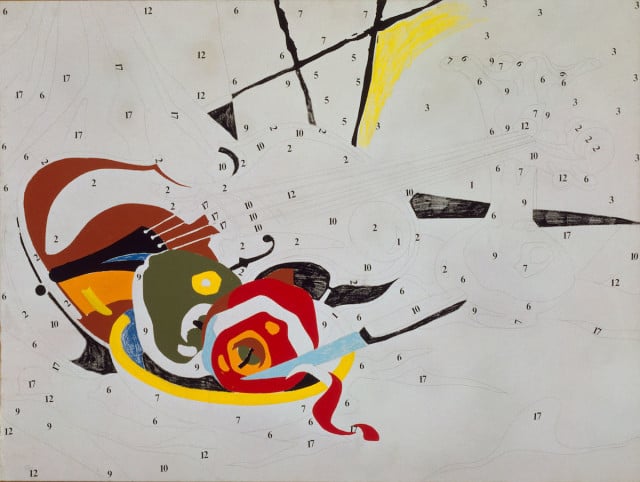
THE DAILY PIC (#1558): Andy Warhol’s Do It Yourself (Violin), from 1962, is one of the gems of the Met Breuer’s “Unfinished” show in New York, which is the subject of all this week’s columns.
Like almost all of Warhol’s Pop art, it is both satire and celebration.
It obviously pokes fun at all the middlebrow Americans who wanted to have a part in making art but demanded yet another labor-saving device to help them get there. Here’s the relevant equation: Paint-by-numbers is to high art as Campbell’s soup is to gastronomy. Both sold like hotcakes – or should I say Pop Tarts – in postwar America, and were obvious signs of its callow consumer culture. Lest readers come back at me with the old saw that Warhol was a true lover of canned and condensed suppers, let me cite plentiful evidence that his favorite meal was actually pasta with caviar. The “simple,” soup-eating boy from working-class Pittsburgh was also a fan of grand opera, serious theater and abstruse avant-garde art.
That last is where the celebration came in when Warhol took on DIY picture making. The canvas at the Met stands in opposition to almost all the traditional artistic values. It rejects the idea of the precious “hand of the artist,” substituting an absolutely mechanical gesture and process instead. It’s in very obvious opposition to the very hand-y art of the Abstract Expressionists, whom Warhol and his peers were eager to supplant; it comes out of the radical composer and thinker John Cage, whose path crossed and recrossed Warhol’s from as early as the 1940s.
Warhol’s DIY painting also suggests that the idea behind a work of art – in the form of the outlines and numbers in the work at the Met – matters more than its final execution and look. For all the areas still left to be colored in, Warhol’s canvas can count as finished and ready-for-showing because it has perfectly explained what would be involved in completing it. In that sense it is the very most finished of all the unfinished pieces in the Met’s Unfinished.
One last thing: “Do It Yourself (Violin)” illustrates almost exactly the process Warhol had already been using in his very first Pop paintings. Once he’d decided on a subject – a vintage typewriter; an old candlestick telephone – Warhol would simply project an image of it on the wall, trace its outlines and then proceed to mechanically fill them in. In several cases he didn’t ever complete that last step, and scholars have wondered to what extent those cases should count as unfinished works. By comparing them to the DIY series, it might be right to say that they were in some sense completed the moment Warhol shone their image onto his wall – or maybe even in the second before he flipped the projector’s switch. But one crucial difference between the earlier projected paintings and the DIYs (which would also have been done from projections, incidentally, thus doubling Warhol’s act of “filling in”) is that the earlier ones read as images of objects, with their photographic sources mostly hidden; the later ones are unavoidably images of art – of real paint-by-number kits – as a filter through which the world gets seen, and reduced.
Warhol’s admirers have often wanted to save his aesthetic bacon by putting him “up there” with the Old Masters. In his art-about-art DIY works, Warhol demands instead to keep company with radical conceptualists – or at least with Sunday number painters. (Private collection; © 2015 The Andy Warhol Foundation for the Visual Arts, Inc./Artists Rights Society (ARS), New York)
For a full survey of past Daily Pics visit blakegopnik.com/archive.